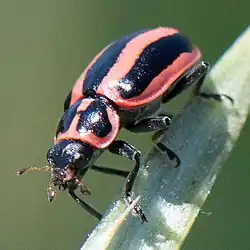Paranaemia
| Paranaemia | |
|---|---|

| |
| P. vittigera, Yolo County, California, 2020 | |
| Scientific classification | |
| Kingdom: | Animalia |
| Phylum: | Arthropoda |
| Class: | Insecta |
| Order: | Coleoptera |
| Suborder: | Polyphaga |
| Infraorder: | Cucujiformia |
| Family: | Coccinellidae |
| Subfamily: | Coccinellinae |
| Tribe: | Coccinellini |
| Genus: | Casey, 1899 |
| Species: | P. vittigera
|
| Binomial name | |
| Paranaemia vittigera (Mannerheim, 1843)
| |
| Synonyms | |
|
Hippodamia vittigera Mannerheim, 1843 | |
Paranaemia is a genus of lady beetles in the family Coccinellidae. There is one described species in Paranaemia, P. vittigera, the broad-striped lady beetle.[1][2][3] The broad-striped lady beetle is native to western North America,[4] where it has been recorded from Alberta to western Texas, west to British Columbia and California.
Description
Adults reach a length of about 4.5-6.6 mm. They have a yellow body and a black head. The pronotum has a large black lateral spot and the elytron has three black vittae.[5]
Biology
Like other ladybugs, it preys on aphids.[6]
References
- ^ "Paranaemia Report". Integrated Taxonomic Information System. Retrieved 2019-09-24.
- ^ "Paranaemia". GBIF. Retrieved 2019-09-24.
- ^ "Paranaemia genus Information". BugGuide.net. Retrieved 2019-09-24.
- ^ "Species Paranaemia vittigera - Striped Lady Beetle". bugguide.net. Retrieved 2024-03-28.
- ^ Gordon, Robert D. (1985). "The Coccinellidae (Coleoptera) of America north of Mexico" (PDF). Journal of the New York Entomological Society. 93 (1). The New York Entomological Society: 1–916. Retrieved August 4, 2025.
- ^ Gardiner, Mary (2015). Good Garden Bugs: Everything You Need to Know about Beneficial Predatory Insects. Quarry Books. p. 83. ISBN 978-1-59253-909-3.
Further reading
- Fürsch, Helmut (1990). "Valid genera and subgenera of Coccinellidae" (PDF). Coccinella. 2 (1): 7–18. ISSN 0935-8196.
- Lobl, I.; Smetana, A., eds. (2007). Catalogue of Palaearctic Coleoptera, Volume 4: Elateroidea - Derodontoidea - Bostrichoidea - Lymexyloidea - Cleroidea - Cucujoidea. Apollo Books. ISBN 978-8788757675.